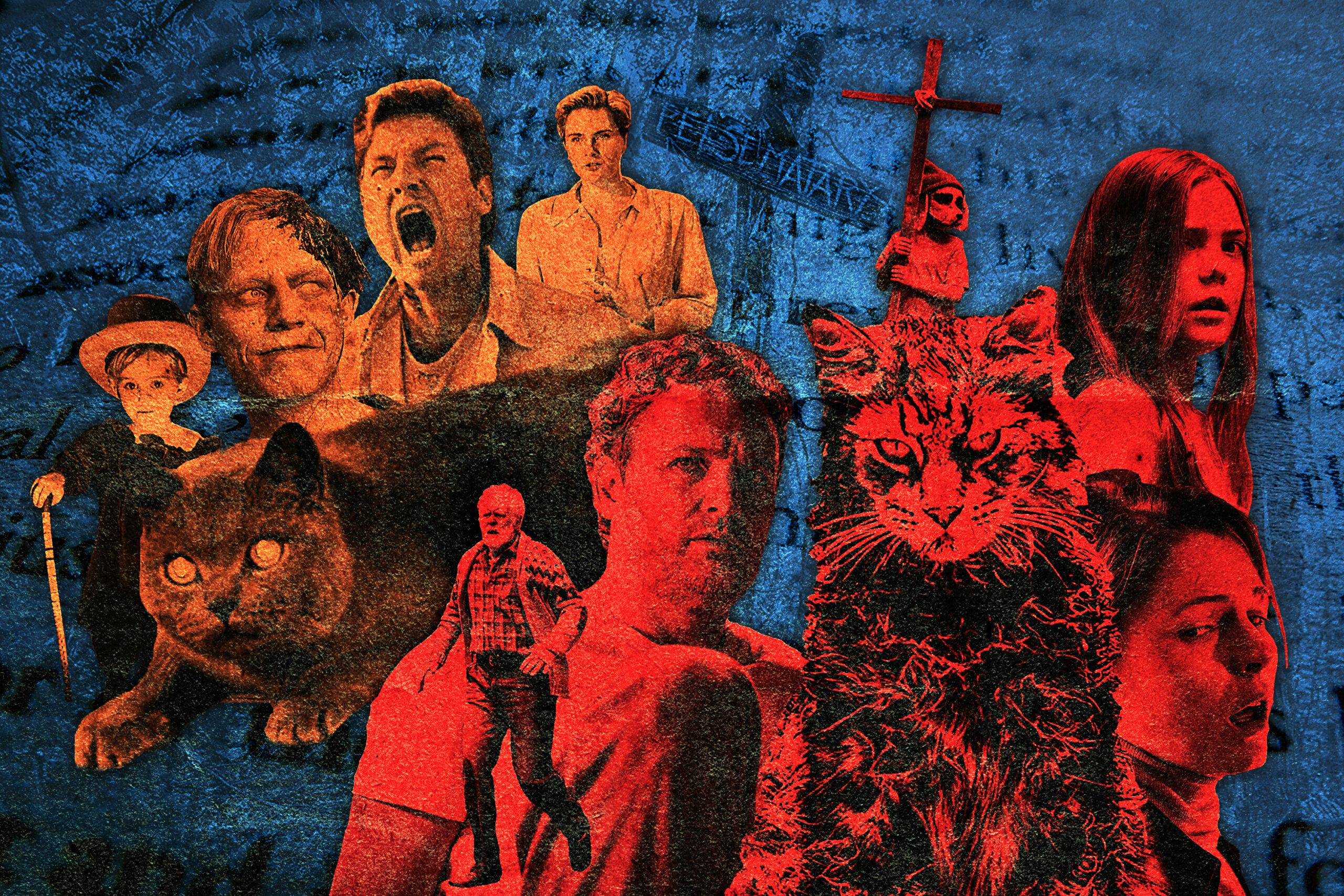

A car pulls up to a secluded colonial and disgorges the average American family: husband and wife, a couple of kids, a cat. Dad has a new job, and his family has accompanied him halfway across the country. He has a temper, too; the children chatter and cry, and he resists the urge to slap them or simply leave and not look back. At first, change seems to suit the little clan. Kids, adults, and feline alike settle into their surroundings, and the strange, stately house starts to feel like home. But the outwardly idyllic setting masks a malevolent entity that has poisoned the region for generations and preys on the recent arrivals. What’s intended to be a fresh start turns into a tragic ending.
That broad-strokes summary sounds reminiscent of Stephen King’s 1977 novel The Shining, but it’s actually an outline of the plot of Pet Sematary, the 1983 novel King started two years after The Shining’s publication. Along with It, The Shining, and maybe Misery, Pet Sematary is probably the leading contender for the title of scariest book by King. Of those four, it’s been the only one without a widely well-regarded movie adaptation. That seems set to change this week, thanks to the release of a remake that arrives 30 years after the uneven 1989 original, in the midst of a King adaptation frenzy incited by the celebrated remake of It. It’s past time for Pet Sematary, one of many King classics marred by a clumsy screen debut, to take its place in the pantheon of King-inspired cinema. On the page, the story remains an unsettling triumph that terrorizes the reader not by pitting its protagonist against an iconic, corporeal villain, but by channeling more mundane fears that are never far from our minds.
King produced a sequel to The Shining in 2013, but he hasn’t written a sequel to Pet Sematary. That could be because King killed off almost all of its characters the first time around. While Jack Torrance is the only casualty in The Shining’s core cast, only one of the five occupants of the car on the first page of Pet Sematary survives. As one might surmise from the title and the evil-looking cat on the book cover and the movie poster, the lucky passenger isn’t Church, the family tomcat, who’s appropriately portrayed as a Maine Coon in the new movie version. Church is the first to go, and he’s also the first to return.
In Stanley Kubrick’s 1980 adaptation of The Shining, the spirit-plagued Overlook Hotel sits atop a Native American burial ground. Another Native American burial ground festers near the Creed family’s cursed property in little Ludlow, Maine (which would later serve as the setting for King’s 1989 novel The Dark Half). Behind the house is a spooky, spiral-shaped cemetery—or, as a misspelled sign christens it, “sematary”—where local kids trek to inter their pets, not knowing why they’re drawn to that particular plot. Deep within the woods beyond that first cemetery lies a second cemetery, the source of a seductive and sickening power. As a few longtime Ludlowites know, pets—or people—buried there are resurrected. But when they come back, they’re at best missing some piece of their soul and at worst possessed by the Wendigo, a cannibalistic, supernatural being that stalks the forest and somehow soured the land.
When Church becomes roadkill, courtesy of the high-traffic route that runs in front of the house, dad and doctor Louis, guided by his octogenarian neighbor Jud, commits the corpse to the burial ground. He’s hoping to spare his daughter, Ellie, the loss of her pet, and himself a difficult conversation, but he’s also unwittingly compelled by the power of the Wendigo, which orchestrates the Creeds’ suffering as It does Derry’s. When Church ungracefully slinks out of the wilderness the next day, he isn’t the same—he hisses, dismembers smaller animals, and smells of decomposing cat—but he’s proof that the dead don’t have to stay that way. Months later, a tanker truck on the same road claims the life of Louis’s toddler, Gage, and his grief drives him back to the burial ground, even though he knows no good can come of attempting to defy death again. When Gage (or something that looks like him) resurfaces, he’s a murderous monster.
Publishers Weekly called Pet Sematary “the most frightening novel Stephen King has ever written,” and King concurs. In a September 2000 introduction to a new edition of the book, he wrote, “When I’m asked, as I frequently am, what I consider to be the most frightening book I’ve ever written, the answer I give comes easily and with no hesitation: Pet Sematary.” King continued, “Pet Sematary is the one I put away in a drawer thinking I had finally gone too far. Time suggests that I had not, at least in terms of what the public would accept, but certainly I had gone too far in terms of my own personal feelings. Put simply, I was horrified by what I’d written and the conclusions I’d drawn.”
Many of the novel’s events have the ring of terrible truth. Like Louis, who finds work in a university infirmary, King uprooted his family to take a job at a school, returning to his alma mater, the University of Maine, for a stint as a visiting instructor in 1978. The house where the Kings stayed stood close to a pet cemetery that was frequently fed by a busy road; during his time there, his daughter’s cat was killed, and his son Owen was almost struck by a truck. King couldn’t help dwelling on how close he had come to bereavement, and how far he would have gone to undo the disaster. That fixation became a book, which he opted not to publish until a contract requirement left him in need of a manuscript to submit. As King recounted in 2000, “I found myself not just thinking the unthinkable, but writing it down,” adding, “I still find it distressing and problematic.” In an interview last week, King revealed that those feelings haven’t faded.
Despite its supernatural trappings, the power of Pet Sematary flows from how it harnesses the natural horrors that cost us all sleep. Most people have kids, and everyone once was one. The thought of losing a child—or even, for that matter, a cherished pet—is painful enough. The prospect of the departed reappearing as something malicious is more disturbing still. How can you overcome an enemy that looks like a loved one?
One might mistake Pet Sematary for a Cujo-style story about killer kitties, but the book’s creepy cat doesn’t kill anything larger than a crow. The original adaptation—which featured both a screenplay and a cameo by King and sold enough tickets to spawn an uninspired big-screen sequel—does sometimes stray into campy territory, but the book succeeds by synthesizing supernatural and psychological horror, like Lovecraft meets Poe meets “The Monkey’s Paw.” Although it gets gory in the end, it’s memorable more for its deft depiction of inner agony than its slasher scenes.
King sets the tone by bringing out the disconcerting side of seemingly innocent scenes. Kids cluster around Mickey Mouse, his “big white cartoon gloves swallowing their small, trusting hands.” A school bus ingests its passengers, and “its doors folded shut with a gasp of dragon’s breath.” We hide death well, but Pet Sematary reminds us that it’s not nearly as distant as it sometimes seems. Recalling his own childhood, Jud tells Louis, “In those days [death] came into the house and said howdy and sometimes it took supper with you and sometimes you could feel it bite your ass.” As Louis learns, those days and these days are kissing cousins. “We’re all close,” he confesses. “All the time.”
As with so much of King’s work, the impression that predominates is the thinness of the membrane between existence and oblivion, and the porousness of the barrier separating what we view as reality from what we tell ourselves is nothing but nightmare. Louis notes that it takes the average person only seven minutes to fall asleep, musing, “Seven minutes for conscious and subconscious to revolve, like the trick wall in an amusement-park haunted house.”
Another neat trick is our capacity for deception and selective amnesia; rather than allow an inexplicable threat to alter your worldview, Louis says, “you simply passed terror intact, like a kidney stone.” Then you pretend you didn’t feel it in the first place, at least until your dead cat comes back to life. Catching a glimpse of himself in a mirror after a fright, Louis is surprised to see how much he looks like his usual self. “It was enough to make you wonder,” he thinks, “how many people were going around with dreadful secrets bottled up inside.”
Pet Sematary telegraphs its central tragedy, but its emotional impact still sneaks up on the reader, because King gives us time to know his creations before he takes them away. On the third page, Gage speaks his first word; by the time the tanker hits him, more than halfway through the book, he’s almost forming full sentences. Early on, Louis chides his wife, Rachel, that death is “perfectly natural,” and he assures Ellie that it’s “an end to suffering.” But when it visits his house, he’ll do anything to make it go away. Fading to black and being forgotten is an awful fate, and fighting it only leads to deeper despair (a theme King recently revisited in another novel, Revival). Death leaves long-lasting scars on the psyche; as a young Louis discovered during his days digging graves as an undertaker’s apprentice, there was never enough dirt to fill them back in and restore the once-smooth surface.
When Jud introduces the idea of the Wendigo midway through the book, he dismisses it as a fiction ancient tribes invented to excuse their own unforgivable behavior. In that framing of reality, the only evil lurks within. It’s almost disappointing when we eventually learn that the evil is out there: The Wendigo comes crashing through the woods, Gage stumbles back to the house and starts stabbing, and Louis finally loses his grasp on his sanity. Pet Sematary mostly lacks a Pennywise, an Annie Wilkes, or even (until the final few pages) a gibbering Jack Torrance, his signals scrambled by the Overlook’s twisted intent. The absence of an adversary makes it all the scarier. Maybe haunted houses aren’t real, and regardless, most of us can steer clear of killer 3-year-olds brandishing scalpels. But we can’t keep outrunning what that horror represents.

